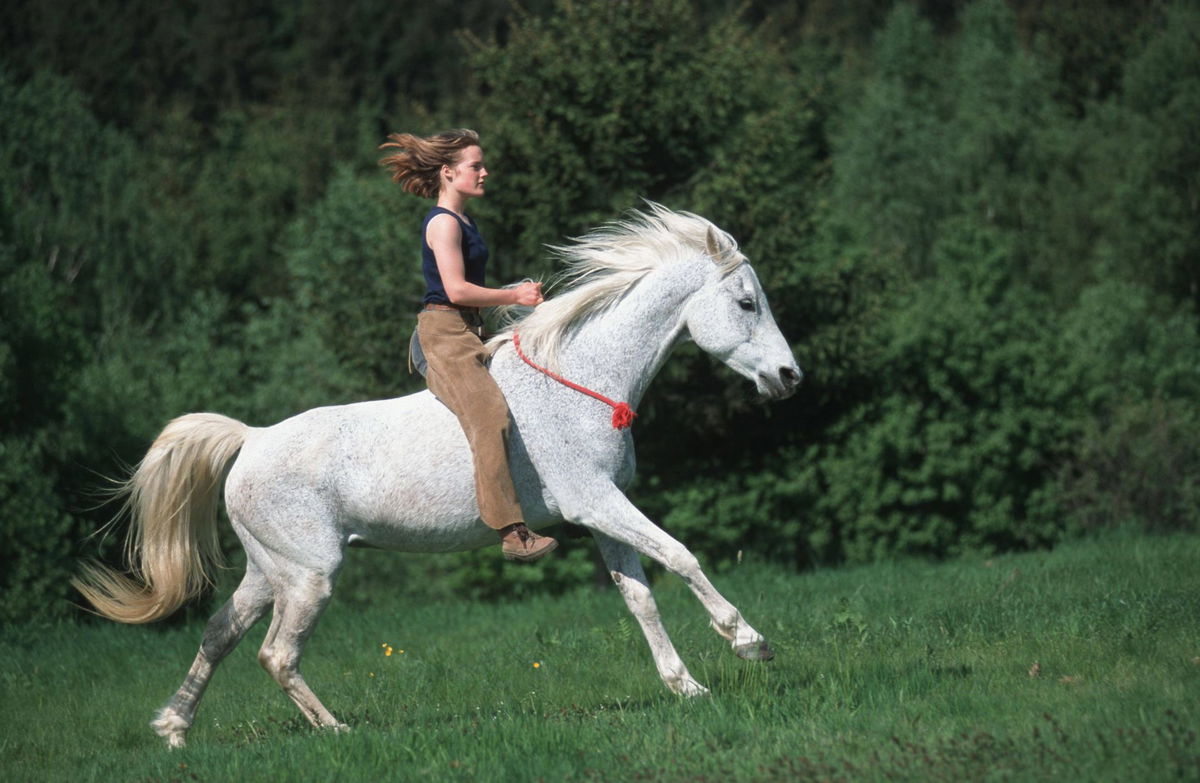
Imago
Bildnummer: 56029680 Datum: 07.08.2004 Copyright: imago/blickwinkel vollblutaraber (equus przewalskii f. caballus), mädchen auf galoppierendem pferd ohne sattel und zaumzeug pure-bred arab horse (equus przewalskii f. caballus), riding girl without saddle blws007554 kbdig 2004 quer tier tiere säugetier säugetiere huftiere unpaarhufer pferd pferde animal animals mammal mammals odd-töd ungulates perissodactyls domestic horse domestic horses mensch menschen person model released symbolfoto personen leute frau fraün reiterin reiterinnen reiten riding human being man woman women equestriennes horsewoman horsewomen bewegung dynamik action dynamisch movement movements motion motions dynamic mädchen girl girls hochformat panel format high size huftier pferderasse pferderassen vollblut vollblutpferd vollblutpferde vollblüter mensch mit tier menschen mit tieren mensch und tier menschen und tiere freizeit aussen freizeitreiten schimmel (pferd) gangart gangarten laufen laufend im lauf galoppieren galoppierend galopp spass seitenansicht von der seite querformat wehend mähne mähnen breed of horse horse breed thoroughbred thoroughbreds with animals and animals leisure outdoor rider white horse white horses pace paces gait gaits galloping running gallop fun side view lateral vertical format horizontal format blowing mane manes 56029680 Date 07 08 2004 Copyright Imago Angle Full-blooded Arabs Equus przewalskii F caballus Girl on galoppierendem Horse without Saddle and Harnesses Pure Bred Arab Horse Equus przewalskii F caballus Riding Girl without SADDLE Kbdig 2004 horizontal Animal Animals Mammal Mammals Hoofed animals Unpaarhufer Horse Horses Animal Animals Mammal mammals Odd fatal ungulates Perissodactyls Domestic Horse Domestic Horses Man People Person Model released Symbolic image People People Woman Women Horsewoman Riders riding Riding Human Being Man Woman Women horse woman Equestrienne horse women Movement Dynamics Action dynamic Movement Movements Motion Motions Dynamic Girl Girl Girls Portrait Panel Format High Size Huftier Horse race Horse races Full blood Thoroughbred horse Thoroughbred horses Thoroughbreds Man with Animal People with Animals Man and Animal People and Animals Leisure exterior Leisure riding Mold Horse gaits gangart run continuously in Run Galoppieren galoppierend Gallop Fun Side view from the Side Landscape wehend Mane Manes Breed of Horse Horse Breed Thoroughbreds With Animals and Animals Leisure Outdoor Rider White Horse White Horses Pace Paces Gait gaits Gallo ping RUNNING Gallop Fun Side View Lateral Vertical Format horizontally Format blowing Mane Manes

Imago
Bildnummer: 56029680 Datum: 07.08.2004 Copyright: imago/blickwinkel vollblutaraber (equus przewalskii f. caballus), mädchen auf galoppierendem pferd ohne sattel und zaumzeug pure-bred arab horse (equus przewalskii f. caballus), riding girl without saddle blws007554 kbdig 2004 quer tier tiere säugetier säugetiere huftiere unpaarhufer pferd pferde animal animals mammal mammals odd-töd ungulates perissodactyls domestic horse domestic horses mensch menschen person model released symbolfoto personen leute frau fraün reiterin reiterinnen reiten riding human being man woman women equestriennes horsewoman horsewomen bewegung dynamik action dynamisch movement movements motion motions dynamic mädchen girl girls hochformat panel format high size huftier pferderasse pferderassen vollblut vollblutpferd vollblutpferde vollblüter mensch mit tier menschen mit tieren mensch und tier menschen und tiere freizeit aussen freizeitreiten schimmel (pferd) gangart gangarten laufen laufend im lauf galoppieren galoppierend galopp spass seitenansicht von der seite querformat wehend mähne mähnen breed of horse horse breed thoroughbred thoroughbreds with animals and animals leisure outdoor rider white horse white horses pace paces gait gaits galloping running gallop fun side view lateral vertical format horizontal format blowing mane manes 56029680 Date 07 08 2004 Copyright Imago Angle Full-blooded Arabs Equus przewalskii F caballus Girl on galoppierendem Horse without Saddle and Harnesses Pure Bred Arab Horse Equus przewalskii F caballus Riding Girl without SADDLE Kbdig 2004 horizontal Animal Animals Mammal Mammals Hoofed animals Unpaarhufer Horse Horses Animal Animals Mammal mammals Odd fatal ungulates Perissodactyls Domestic Horse Domestic Horses Man People Person Model released Symbolic image People People Woman Women Horsewoman Riders riding Riding Human Being Man Woman Women horse woman Equestrienne horse women Movement Dynamics Action dynamic Movement Movements Motion Motions Dynamic Girl Girl Girls Portrait Panel Format High Size Huftier Horse race Horse races Full blood Thoroughbred horse Thoroughbred horses Thoroughbreds Man with Animal People with Animals Man and Animal People and Animals Leisure exterior Leisure riding Mold Horse gaits gangart run continuously in Run Galoppieren galoppierend Gallop Fun Side view from the Side Landscape wehend Mane Manes Breed of Horse Horse Breed Thoroughbreds With Animals and Animals Leisure Outdoor Rider White Horse White Horses Pace Paces Gait gaits Gallo ping RUNNING Gallop Fun Side View Lateral Vertical Format horizontally Format blowing Mane Manes
The equestrian community was captivated by the recent post surrounding Danielle Jane Branch. The 14-year-old horse lover, took to Instagram to share her delightful experience with an equestrian simulator that she found to be truly flawless. The video elicited a multitude of reactions from online users, with some expressing appreciation for the smoothness it provided while others voiced their unwavering preference for horseback riding.
Watch What’s Trending Now!
Equestrian simulators have gained immense popularity as effective tools for training and improving skills. These devices, designed to replicate the motion and behavior of real horses, offer numerous advantages that make them invaluable.
ADVERTISEMENT
Advantages of Equestrian Simulators
Simulators offer a safer and more easily approachable option, especially for those who are new to riding. Individuals may feel anxious or hesitant, to ride real horses, particularly those with disabilities. These simulators provide riders with the opportunity to practice and enhance their skills in a controlled setting. It ultimately bolsters their confidence levels prior to engaging in live horseback riding.

ADVERTISEMENT
Furthermore, simulators offer riders the invaluable opportunity for instant feedback and analysis about their position, balance, and coordination. This real-time insight empowers riders to swiftly recognize and rectify any flaws, ensuring a continual improvement in their abilities. The capability of receiving rapid feedback proves exceptionally beneficial for individuals aiming to perfect their skillset within specific equestrian disciplines like racing, dressage, jumping, or eventing. Nonetheless, Danielle’s choice of using riding simulators sparked divergent opinions among netizens.
ADVERTISEMENT
Real vs Simulation: What Works for Equestrians?
While some fans recognized the benefits of equestrian simulators, others held reservations regarding their ability to emulate the genuine horse-riding experience.
Top Stories
Forced to Leave FOX, Cowboys Legend Troy Aikman Says ESPN Is Like ‘U.S. Government’ & Clearly Distinguishes the Two Networks

NFL Files Motion to Dismiss Former Texans Board Member Cary McNair’s “Legally Baseless” Lawsuit

$250M Michigan Booster Reveals More to Sherrone Moore Saga After Paige Shiver Confirms Police Visit

T.J. Watt’s Wife Shares Emotional Update on Steelers LB Following Worrying Health Scare

Rafael Nadal Faces New Injury Blow Only a Year After His Emotional Tennis Exit

Heisman Voter Flags Julian Sayin Disrespect as Fernando Mendoza and Diego Pavia Announce True Intentions

One fan expressed their standpoint against simulators, saying, “I understand why people use these. But God do I hate them. I just hate them. To me unless you feel the horse breath ( and it’s chest expand) between your legs you aren’t actually riding. But that’s just a personal opinion.” Simulators as advanced as they may be, still fall short in capturing the emotional bond and communication between a rider and their horse.
ADVERTISEMENT
View this post on Instagram
Another fan humorously commented, “Yeah except the real version isn’t always that smooth”, emphasizing the real horses’ unpredictable nature. However, amidst the responses, some individuals voiced their longing for the seamless quality displayed in the simulator experience. A fan expressed, “I wish it was this smooth.” Another eagerly commented, “I wanna try one of these so bad”.
Also Read: Wholesome Bond Between Equestrian and Mare Comes to an End With a Tragic Fate After 28 Years
ADVERTISEMENT
Although it does have benefits, it is essential to recognize its limitations. Unlike real horses, the simulators can’t replicate the intricate forms of communication cultivated between riders and living horses. Ultimately, deciding which route to take, whether through simulators or not, is a subjective decision that hinges on individual preferences within the domain of equestrian pursuits.
Watch This Story: Series of Unfortunate Events Baffle Equestrian World as Cowboy Falls Prey to Accidental Shooting
ADVERTISEMENT
ADVERTISEMENT
ADVERTISEMENT

